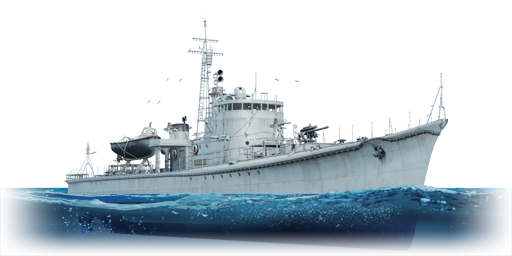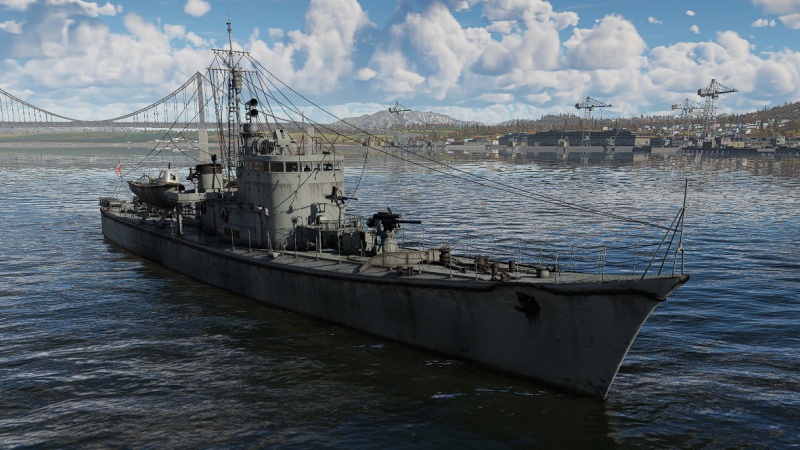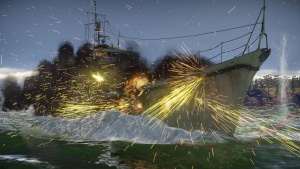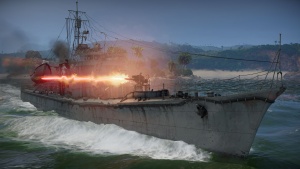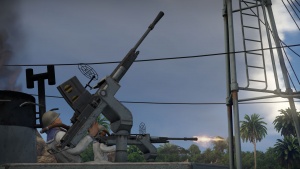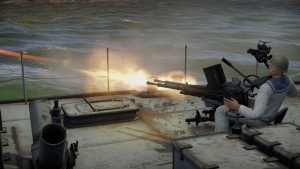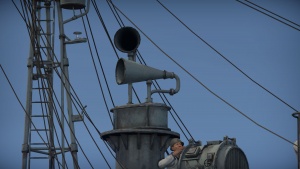Type K-8 No.13 late
| This page is about the Japanese sub-chaser Type K-8 No.13 late. For the other version, see Type K-8 No.13. |
Contents
Description
The Japanese Project K8, No.13-class Submarine Chasers were built as a part of the Maru 4 Programme. The lead ship of her class was completed in July 1940, while the last ship was completed in January 1942, with a total of 15 vessels built. During WW2, most of the vessels of the class were re-armed with 25 mm Type 96 guns and fitted with 22-GO radar. They fought primarily in the southern seas, from the Philippines to Bali Island, but also participated in numerous convoy escorts. Only five vessels of the class survived the war.
The Type K-8 No.13, Kusentei late modification is a Japanese sub-chaser introduced in Update 1.89 "Imperial Navy". She has exceptional survivability combined with very good armament for her BR. She struggles most in mobility, which is not helped by being a comparatively large vessel for the BR, making her a very attractive target to motor torpedo boats and enemy bombers alike. Compared to her predecessor, she improves on survivability and armament, at the expense of significantly lower speed and manoeuvrability.
General info
Survivability and armour
The Type K-8 No.13, Kusentei late modification's primary characteristic is her exceptional survivability for the battle rating. With a crew count of 80, she's got nearly the double of the second-best vessel, and nearly 7 times the crew count of any US vessel in this battle rating. She's also the only ship within the battle rating to have 7 hull sections, at least one more than all the other ships. Overall this gives her an outstanding ability to survive even a focused gun fire from multiple boats.
The Type K-8 No.13 late still has some weak points to her survivability. First of all, she has one of the thinnest armour layers, making it impossible to deflect even the lowest calibre guns at nearly any range. Secondly her primary gun is fully exposed, leading to it being often disabled under enemy fire. And lastly her ammunition storage is exposed fully over the water level, directly under the primary gun, making for a significant chances of ammo-racking the ship.
Mobility
With the top speed of 33km/h, she's a relatively large, lumbering target. It's not helped by an average rudder turning speed of 4.85s. Overall it's an attractive target for a torpedo attacks and a long-range gunnery fire.
| Mobility Characteristics | |||
|---|---|---|---|
| Game Mode | Upgrade Status | Maximum Speed (km/h) | |
| Forward | Reverse | ||
| AB | |||
| Upgraded | 45 | 16 | |
| RB/SB | |||
| Upgraded | 30 | 11 | |
Modifications and economy
Armament
Primary armament
The Type K-8 No.13 late's primary armament is a single 8 cm Type 3 cannon. It can fire up to 20 shots/minute of Type 0 HE shells that are relatively potent, with 480 g of TNT, being able to knock out individual hull sections on most boats she'll encounter, but struggling with larger units like submarine chasers.
The gun was originally designed as a high-elevation one, historically being often mounted on a larger ships for anti-aircraft duty. As a result, her horizontal guidance is ±180° and vertical -7°/+75°, covering most of the field around the ship with exception of the deadzone behind the conning tower, although the gun can still engage airborne targets by firing above it. Targetting speed is slow, just 9.4°/s, however it's sufficient to engage targets bar fast attack boats in an extremely short range where machine guns engage them anyway.
| Penetration statistics | |||||||
|---|---|---|---|---|---|---|---|
| Ammunition | Type of warhead |
Penetration @ 0° Angle of Attack (mm) | |||||
| 100 m | 1,000 m | 2,000 m | 3,000 m | 4,000 m | 5,000 m | ||
| Type 0 HE | HE | 8 | 8 | 8 | 8 | 8 | 8 |
| Type 0 HE | HE-TF | 8 | 8 | 8 | 8 | 8 | 8 |
| Shell details | ||||||||||||
|---|---|---|---|---|---|---|---|---|---|---|---|---|
| Ammunition | Type of warhead |
Velocity (m/s) |
Projectile mass (kg) |
Fuse delay (m) |
Fuse sensitivity (mm) |
Explosive mass (TNT equivalent) (g) |
Ricochet | |||||
| 0% | 50% | 100% | ||||||||||
| Type 0 HE | HE | 685 | 5.99 | 0 | 0.1 | 480 | 79° | 80° | 81° | |||
| Type 0 HE | HE-TF | 685 | 5.99 | 0 | 0.1 | 480 | 79° | 80° | 81° | |||
Secondary armament
Same as the predecessors Type K-3 No.1 and Type K-7 No.4, this boat is equipped with three single mounting 25 mm Type 96 autocannons, which make for a very potent secondary weapons. The HE type rounds this gun fires have no trouble knocking out PT boats and even larger support vessels, sometimes even with one magazine all together. Alternatively, AP racks can be used for handling armoured boats with a penetration of up to 37 mm at 1,000 m range, which is more than enough to penetrate even hardened armour gun shield of German boats.
Two of the cannons are placed on a platform in front of the smoke funnel, while the third one is located right behind the primary cannon, in a super-firing position. Additionally due to the HE these cannons can engage targets at range and still do damage. This cannon can also cause critical damage to aircraft with only a single hit.
Note that the autocannon in a front mount has significantly decreased guidance arc. While for the two guns on the platform amidship have horizontal guidance of ±180°, the front one has only -90°/+40°, which means that the guns have a relatively narrow arc where majority of the secondary guns can fire.
- Universal: HEF-T* · HEF · AP-T · HEI - Good balance between firepower and tracer contents, useful for newcomers to the Japanese 25 mm autocannon.
- APT: AP-T · AP-T · AP-T · HEF - Full of AP shells, it's recommended to take a few belts of AP in case you meet a Russian armoured river boat.
- HEIT: HEF-T* · HEI · HEI · HEI - Trades tracer rounds for extra firepower, they're more efficient than Universal belts at knocking out PT boats and aircraft at the expense of price. Universal belts are free, while APT and HEI belts cost 5
 each.
each.
| Penetration statistics | |||||||
|---|---|---|---|---|---|---|---|
| Ammunition | Penetration @ 0° Angle of Attack (mm) | ||||||
| 10 m | 100 m | 500 m | 1,000 m | 1,500 m | 2,000 m | ||
| HEF-T* | 2 | 2 | 2 | 2 | 2 | 2 | |
| HEI | 2 | 2 | 2 | 2 | 2 | 2 | |
| HEF | 2 | 2 | 2 | 2 | 2 | 2 | |
| AP-T | 55 | 53 | 43 | 33 | 25 | 19 | |
| Shell details | ||||||||||||
|---|---|---|---|---|---|---|---|---|---|---|---|---|
| Ammunition | Velocity (m/s) |
Projectile mass (kg) |
Fuse delay (m) |
Fuse sensitivity (mm) |
Explosive mass (TNT equivalent) (g) |
Ricochet | ||||||
| 0% | 50% | 100% | ||||||||||
| HEF-T* | 900 | 0.24 | 0 | 0.1 | 8.5 | 79° | 80° | 81° | ||||
| HEI | 900 | 0.26 | 0 | 0.1 | 5.52 | 79° | 80° | 81° | ||||
| HEF | 900 | 0.25 | 0 | 0.1 | 23.93 | 79° | 80° | 81° | ||||
| AP-T | 900 | 0.28 | - | - | - | 47° | 60° | 65° | ||||
Anti-aircraft armament
Unlike predecessors, this boat have separate anti-aircraft armament which consists from twin Type 93 (13.2 mm) machine guns on a single mount at the rear of the ship. It has a notable advantage in vertical guidance over the Type 96 automatic cannons, being able to aim at targets up to +80° vs +65° for the Type 96. Also having nearly double the fire rate further increases its chances of landing successful shots at the enemy. Even with two bullets hitting the enemy, the overall damage is much lower, with 13.2 mm HEI bullet bearing 1 g TNT, while 25 mm HEI bears 15.3 g TNT.
Additional armament
Describe the available additional armaments of the ship: depth charges, mines, torpedoes. Talk about their positions, available ammunition and launch features such as dead zones of torpedoes. If there is no additional armament, remove this section.
Usage in battles
The primary role of the Type K-8 is to lure enemy's attention away from more vulnerable targets. Being large, intimidating ship it will often be under fire of a number of enemy units. And often times it can freely survive those engagements, largely thanks to its 8cm main gun packing powerful punch, although delivered at a low fire rate, and assisted by a number of secondaries at all angles.
Pros and cons
Pros:
- Excellent survivability
- Good armament
- 360° weapon coverage
- Good anti-aircraft capability
- Main gun able to engage aircraft
Cons:
- Slow speed and low manoeuvrability
- Large target
History
Submarine chasers of the project number K8, also known as the No.13-class submarine chasers (第十三号型駆潜艇, Dai 13 Gō-gata Kusentei), were built under Maru 4 Keikaku programme, totalling 15 ships built from 1940 till 1942. The primary principle of the design was to build capable ships quickly and cheaply. The resulting design used cheaper, more common steel found on merchant ships, not military units. But an additional reinforcements created a notably sturdier hull, which also helped avoiding secondary vibrations due to the sonar. Furthermore, the ship had an increased ballast, lowered centre of gravity and an increased hull width what resulted in a ship having displacement roughly 1.5 times the one of its predecessor, the Type K-7 No.4.
Ships of class
| Name | Completed | Fate at the end of the war | Dismantled post-war | ||
|---|---|---|---|---|---|
| Status | By | Date | |||
| No. 13 | 1940-07-15 | Sunk | Submarine, USS Pickerel (SS-177) | 1943-04-03 | |
| No. 14 | 1941-03-31 | Destroyed | Aircraft | 1945-07-28 | |
| No. 15 | 1941-03-31 | Survived | 1948-04-23 | ||
| No. 16 | 1941-04-05 | Sunk | Aircraft | 1944-07-04 | |
| No. 17 | 1941-07-31 | Sunk | Submarine, USS Springer (SS-414) | 1945-04-28 | |
| No. 18 | 1941-07-31 | Sunk | Aircraft | 1944-12-30 | |
| No. 19 | 1941-09-20 | Survived | 1948 | ||
| No. 20 | 1941-08-20 | Survived | 1948-05-04 | ||
| No. 21 | 1941-08-20 | Survived | 1947 | ||
| No. 22 | 1941-10-12 | Sunk | Aircraft | 1944-02-19 | |
| No. 23 | 1941-11-15 | Survived | 1948 | ||
| No. 24 | 1941-12-20 | Sunk | Destroyer, USS Burns (DD-588) | 1944-02-17 | |
| No. 25 | 1941-12-29 | Sunk | Submarine, USS Grunion (SS-216) | 1942-07-15 | |
| No. 26 | 1941-12-20 | Sunk | Aircraft | 1945-07-30 | |
| No. 27 | 1942-01-28 | Sunk | Submarine, USS Grunion | 1942-07-16 | |
No. 13 and No. 14 took part in a hunt for USS Nautilus (SS-168) in June 1942, damaging the submarine with depth charges and forcing it back to Pearl Harbor for month-long repairs. The No. 27 was likely the last victim of the USS Grunion, before the latter was sunk 4 days later. No. 18 sunk USS Amberjack (SS-219) on 16 February 1943. In October 1943, No. 15 took part in the sinking of submarine USS Wahoo (SS-238). On 14 November 1943, the No. 20 engaged in a gunnery duel with the HMS Taurus (P399), with the submarine hitting the bridge of the chaser with its QF 4-inch Mk IV (102 mm) gun, killing the captain and most of the crew onboard. The ship suffers a number of other hits that eventually flood her engine room forcing the ship to be towed back into the port for repairs. The submarine returned back to the port undamaged, despite No. 20's crew claiming a direct hull hit and dropping a number of depth charges.
08 August 1945 marks the most successful anti-aircraft duty of the class, with the No. 19 damaging six out of fourteen B-25 bombers trying to strafe it in the Tsushima Strait between Japan and South Korea. The ship suffered one bomb hit, but survives the encounter and returns back to the Kure port, about 20 km away from Hiroshima just days after the atomic bombing.
Ships of the class also participated in a number of rescue operations, such as No. 17 and No. 18 rescuing of nearly 400 survivors of the bombing of a Naples Maru troop transport or No. 20 rescuing 622 survivors after an attack on a convoy departing from the Musa Bay in the September 1944.
22-GO Radar
The two rotating devices on top of the conning tower of the Type K-8 are not acoustic listening devices, but rather a radar. Each of the two devices are built of a dipole antenna inside a large, cone-like horn antenna. Its designation is 22-GO (22号電探), also known as Navy Mark 2 Type 2 Radar. Colloquially it was called "Horns" among Americans and "Tuna" among Japanese sailors.
It was designed as a search radar. First test phase was done onboard battleship Hyūga in May 1942, with further testing proceeding onboard Yamato in July 1943. It went through a number of updates, eventually reaching nearly 1,000 units produced by the end of the war. The mass deployment begin in July 1944, eventually reaching most of the Japanese naval units. After the war, radars found their use onboard whaling vessels helping to mitigate the food shortage in the post-war period by ensuring a safe passage of the vessels between the icebergs in the northern seas.
The radar suffered from relatively low accuracy, making it not suitable for fire-control applications. It had an average range error of 160 metres and an average bearing error of 2.26°. It was able to detect battleships at 35 km range, destroyers at 16 km and submarines at 5 km. Testing onboard Yamato also proved that the radar can detect a water column from Yamato's 155 mm secondary cannons from up to 15 km.
Media
- Skins
See also
Ships of comparable role, configuration and era
- Type K-7 No.4 (predecessor)
- Pr.191M (comparable USSR armoured gun boat)
External links
- [Wikipedia] No.13-class submarine chaser
- [Imperial Japanese Navy Page] IJN Subchaser CH-13: Tabular Record of Movement
- Ships of the World - Escort Vessels of the Imperial Japanese Navy (Special Issue Vol. 45) (世界の艦船 - 日本海軍護衛詳艇史 (増刊第45集條 1996.No.507)) pages 70-73
| Nippon Kokan Co. (日本鋼管株式会社) | |
|---|---|
| Sub Chasers (駆潜艇) | |
| No.13 Type | Type K-8 No.13* · Type K-8 No.13 late* |
| *Previously Tsurumi Iron Works | |
| Japan sub-chasers | |
|---|---|


